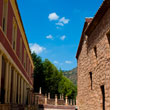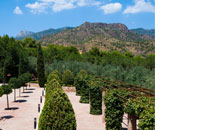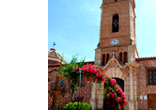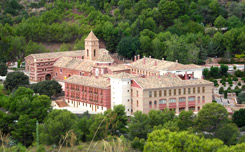




The Sanctuary of Santa Eulalia de Mérida, patron saint of Totana, is one of the most popular places outside of the town. Situated in a beautiful spot at the foot of Sierra Espuña, 7km from Totana and 600m above sea level. It’s accessible by a road surrounded by pine groves and orchards where stately houses of the last century are built.
The sanctuary originates from the end of the first century; documentation exists from the 14th century where the existence of a small sanctuary is mentioned. Built by the Order of Santiago, on land given by King Alfonso X ‘El Sabio’ to Don Pelayo Pérez (Head of the Order of Santiago).
On December 10 the followers of Santiago took possesion of Aledo and Totana, the day which commemorates the death of Eulalia de Mérida.
The present day sanctuary was built by the followers as a charitable gesture in 1574. Arround this time a Council Act report was released stating "there had been a hermit who abandoned the place because of the war", a man named Alonso de Murcia then installed himself there. He and his son gave wine for charity. Later the place became property of a Ginés Arredo, who decided against continuing the custom established by his predecessors. Consequently, the Town Hall fined him, obliging him to "deliver wine to whoever should ask for it". Soon the town council became interested in the hermitage as a centre of worship and promoted its first restoration in 1498. It was already described as "a nave with good walls, covered in good wood, a good flat roof and good doors with an iron lock". You can also find a description of the Saint "Striking, she had a green skirt and a linen blouse, some black beads and a small purple cloak from London trimmed with silk, a corset with sleeves and a dark ribbon".
At the end of the 16th century devotion to the Saint grew, believing her to have miraculous powers, curing the sick and the crippled who drank from the fountain situated opposite the Hermitage.
The church is Tuscan style formed by a central rectangular nave, the roof is a mixture of wood and crafted Mudejar. Inside, the focal point of the the main alter is the work of Jerónimo Caballao and it´s dated from 1717.
In the 18th century various reforms were carried out to widen the body of the hermitage and to build a baroque octagonal camarin (small room behind the altar) built upon the cavern is the place where it is believed the Saint appeared and where the first altar was built. The walls are covered with paintings dating from 1624 and they depict the life and miracles of the Saint and Jesus Christ. The work, of approximately 200 square meters, with 48 scenes divided in two strips, includes a total of 216 main figures and is attributed to friar Antonio Bernón, who acted on the express request of the frequent visitor Don Diego Ramírez of Arellano (Order of Santiago), where the Priest told him about the large number of miracles that the "Blessed Saint Eulalia had performed". The marvels were painted on the church walls by an exceptional artist and are so well looked after that they cause devotion by the worshippers. The paintings act as a backdrop the Spanish Coat of Arms, the Order of Santiago, Totana, Aledo, Murcia, Cartegena, Lorca, Caravaca and Yeda.
The line separating the murals was drawn by the Fransican Order. Saint Eulalia de Mérida (292 ac) was raised to the altar by Pope Urbano VIII in 1644. She was proclaimed Patron Saint of almost all of Christian Spain and nowadays is the only Español Saint from the first century which has remained present amongst the religious Saints. Her remains are preserved in Oviedo Cathedral. There is a traditional pilgrimage on the 7th January in honor of the Saint where the people from Totana and visitors come together in honor of the Patron Saint, enjoying it as a religious, openly traditional and gastronomic holiday.